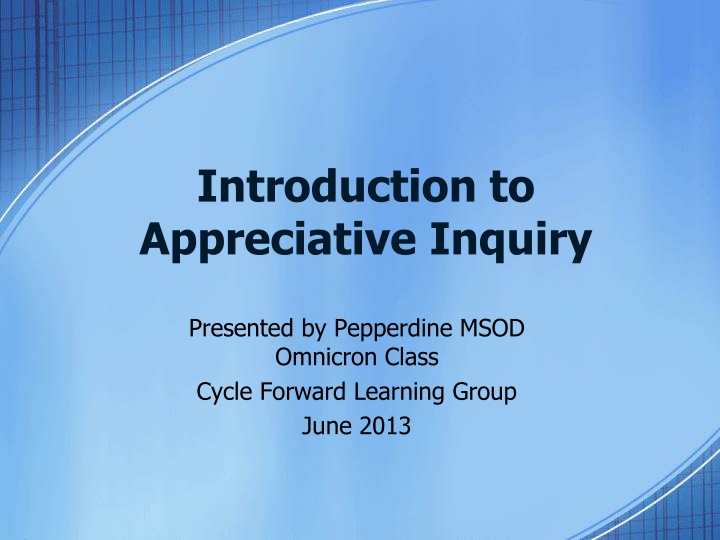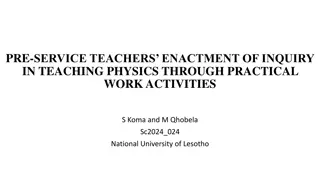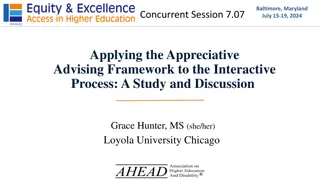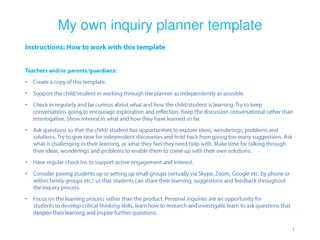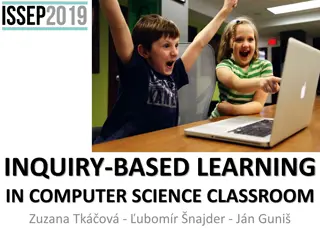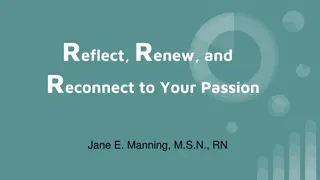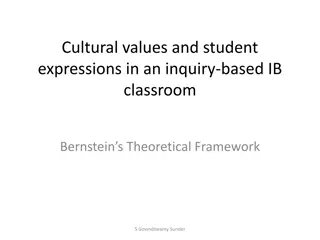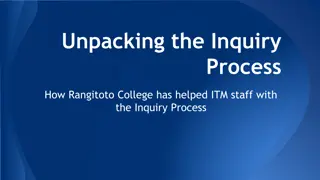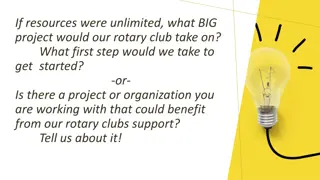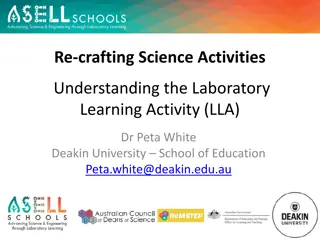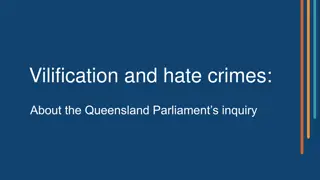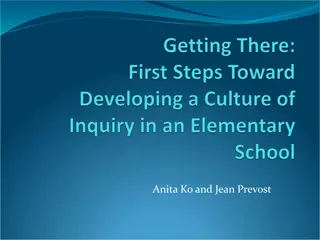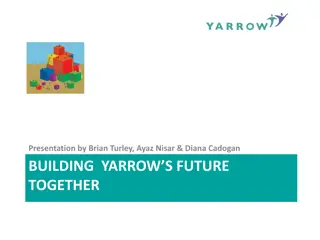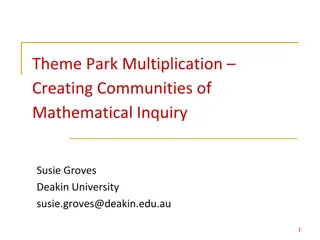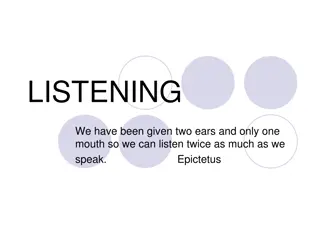Appreciative Inquiry: Learning Objectives and Techniques
Gain a basic understanding of Appreciative Inquiry (AI) techniques, experience its positive impact, and learn how and when to apply AI. Explore the AI resource toolbox for future use. Understand the difference between traditional problem-solving approaches and AI problem-solving. Dive into the process of AI, from identifying felt needs to innovating and taking action. Engage in AI exercises like pair interviews to uncover high-point experiences and personal best moments.
Download Presentation

Please find below an Image/Link to download the presentation.
The content on the website is provided AS IS for your information and personal use only. It may not be sold, licensed, or shared on other websites without obtaining consent from the author.If you encounter any issues during the download, it is possible that the publisher has removed the file from their server.
You are allowed to download the files provided on this website for personal or commercial use, subject to the condition that they are used lawfully. All files are the property of their respective owners.
The content on the website is provided AS IS for your information and personal use only. It may not be sold, licensed, or shared on other websites without obtaining consent from the author.
E N D
Presentation Transcript
Introduction to Appreciative Inquiry Presented by Pepperdine MSOD Omnicron Class Cycle Forward Learning Group June 2013
Module Objectives Gain basic understanding of Appreciative Inquiry (AI) techniques Experience the positive impact of AI Learn how and when to use/apply AI Exposure to AI resource toolbox for future use
Traditional Problem Solving Vs AI Problem Solving Appreciative Inquiry Felt Need Identification of Problem Appreciating Valuing the Best of What Is Envisioning What might be Analysis of Cause Analysis of Possible Solution Dialoguing What Should Be Action Planning (Treatment) Innovating What Will Be From Cooperrider, D. L., Whitney, D., Stavros, J. M. (2008). Appreciative Inquiry Handbook (2nd ed.). Brunswick, OH: Crown Custom Publishing, Inc.
Ap-preci-ate, v., In-quire (kwir), v., to value or admire highly; to judge with heightened understanding; to recognize with gratitude. to search into, investigate; to seek for information by questioning. From Cooperrider, D. L., Whitney, D., Stavros, J. M. (2008). Appreciative Inquiry Handbook (2nd ed.). Brunswick, OH: Crown Custom Publishing, Inc.
AI Exercise 4 Parts Learning Group Sharing What You HEARD Find Common Themes & Establish Actions Pair Pair Interviews Part I Interviews Part II Part I & II Part III 30 mins 25 mins Note: Pairs should be within Learning Groups Trios when necessary
Pair Interview Questions Part I Instructions: Person A interviews person B using the following questions. Feel free to take notes to be prepared to report out to your learning group later. (Then reverse Roles) Questions: 1. What would you describe as being a high-point experience while in France, a time when you were most alive and engaged? 2. When were you at your personal best? 3. What are the core factors that made our cohort most effective on this trip?
Pair Interview Questions Part II Instructions: Follow same process as Part I Question: Imagine you have awaken after a long, deep sleep . You wake up and you have just finished the November trip to Costa Rica. Your ideal state has become the reality. What do you see? What happened on the trip? How were things better than the France practicum?
Learning Group Exercise Part III In your learning group, share what YOUR PARTNER told you during the interview (everyone should be heard; ~2min per person) Everyone should take notes Record high point common themes on a flip chart Images of the future: How can you apply this in the future - identify what the group wants to do different for the Costa Rica practicum to make it the best session imaginable Be prepared to share one brief highlight with the cohort
In the interest of time we will only cover 2-3 of slides #11- 14 (there will not be enough time to do them all) Five AI Principles Positive Principle Anticipatory Principle Simultaneity Principle Poetic Principle Constructionist Principle From Cooperrider, D. L., Whitney, D., Stavros, J. M. (2008). Appreciative Inquiry Handbook (2nd ed.). Brunswick, OH: Crown Custom Publishing, Inc.
In the interest of time we will only cover 2-3 of slides #11- 14 (there will not be enough time to do them all) The AI 4-D Model of Positive Change Discovery What gives life? The best of what is. Appreciating Dream Destiny Affirmative Topic What might be? Envisioning Results/Impact How to empower, learn, and improvise? Sustaining Design What should be the ideal? Constructing the future From Cooperrider, D. L., Whitney, D., Stavros, J. M. (2008). Appreciative Inquiry Handbook (2nd ed.). Brunswick, OH: Crown Custom Publishing, Inc.
In the interest of time we will only cover 2-3 of slides #11- 14 (there will not be enough time to do them all) Why AI Works The 6 Freedoms Free to be Known in Relationship Free to Be Heard Free to Dream in Community Free to Choose to Contribute Free to Act with Support Free to Be Positive
In the interest of time we will only cover 2-3 of slides #11- 14 (there will not be enough time to do them all) What s Different About AI? Purposefully positive Builds on past success Grass Roots and top down Highly participative Nurtures a positive inner dialogue Stimulates vision and creativity Accelerates change From Cooperrider, D. L., Whitney, D., Stavros, J. M. (2008). Appreciative Inquiry Handbook (2nd ed.). Brunswick, OH: Crown Custom Publishing, Inc.
Creating Engaging AI Questions State questions in the affirmative Begin with a leading questions that builds on affirmative topic choice Give a broad definition to the topics Invite participants to use storytelling and narratives Phrase in rapport talk, not report talk Allow ambiguity because it gives room to swim around Value what is Spark the appreciative imagination by helping the person locate experiences that are worth valuing Convey unconditional positive regard Evoke essential values, aspirations and inspirations Note: Every question most begin with a positive preface From Cooperrider, D. L., Whitney, D., Stavros, J. M. (2008). Appreciative Inquiry Handbook (2nd ed.). Brunswick, OH: Crown Custom Publishing, Inc.
Evolution of Uses of AI Over the Last Thirty Years Timeline Late 1980s 1990s Approach Interviews Focus Groups Early Mid 1990 s Small Conference Late 1990 s Large Conference Early 2000s Mega Conference Scope 1-1 Sampling Most / all engaged Plant / Site Whole System All stakeholders: Large team plus consultants Cross- systems Nations / Religions Several teams, army of consultants Example Team / Small Dept 1-2 people Med/Large Dept Small team Planning Large team Meetings New product development Strategic Planning Work process redesign Organization culture change Organization transformation Surveys And many more Acquisition Integration Change initiatives Coaching Diversity Initiatives Employee Engagement efforts Focus Groups Leadership & Team development
Overview of Toolkit List of recommended books on AI Free videos on YouTube Sample presentations (including this one) on AI Cheat Sheet AI concepts
EXTRA INFORMATION
Things to take to France Exercise Instructions (Louise) Hard copy of presentation (Louise) Job Aides (Kim) Books (Louise 3, Kim 1) Markers (Louise) Surveys (Val)
